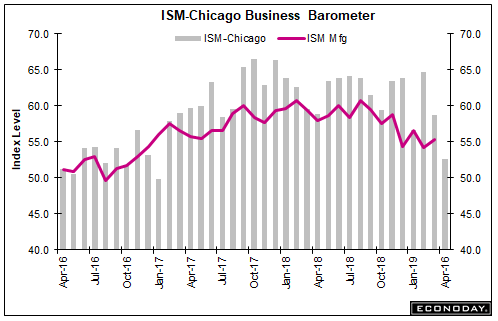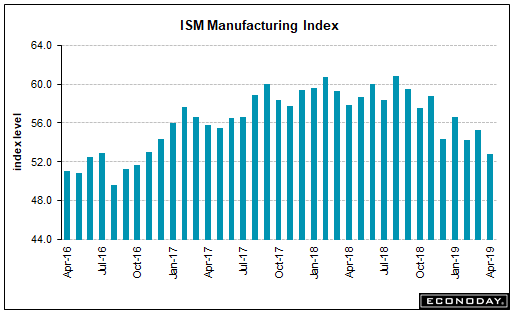The Federal Open Market Committee meeting was hardly a blip on the radar as interest rates remained unchanged accompanied by another call for patience. Trading on the stock markets had been shifting towards higher risk assets leading up to and through the meetings.
With core inflation falling short again of the 2 percent goal, the pressure on the Fed to raise rates is growing. The window for attracting capital investments isn’t shrinking but rather on a timer waiting to shut.
U.S. manufacturing PMI was down to 52.8 in April according to the recent report from the Institute of Supply Management (ISM). \. Inventories are being drawn down as this is the sharpest monthly fall in prices since December 2008. Analysts attribute part of the drop in part to lower steel costs. New orders were particularly hard hit falling 5.7 points in April. Employment fell 5.3 points to a 52.4 indexed growth rate.

Here’s what some of the ISM survey respondents had to say:
- "Business conditions remain largely unchanged. There is growing concern about supply chain product flow through the southern U.S. border. Price pressures remain, and inventories continue to grow in preparation for what is expected to be a growth year." (Electrical Equipment, Appliances & Components)
- "Mexico/U.S. border crossing delays are slowing supplier deliveries. Tariffs are resulting in increased prices on computer components, as well as manufacturers moving out of China to countries not impacted by the tariffs. Brexit expected to result in delays on moving product through the United Kingdom." (Computer & Electronic Products)
- "January and February were strong months. March softened significantly, eroding some of the [previous months'] gains." (Chemical Products)
- "[We are] closely watching the Mexico border situation as well as the tariff situation." (Transportation Equipment)
- "Economy is holding steady, and so are prices. Supply availability is generally OK, yet risk remains in chemicals and some longer lead-time packaging." (Food, Beverage & Tobacco Products)
- "Raw material prices continue to come down, along with logistics costs. Suppliers continue to struggle to get [qualified workers], and the learning curve is leading to quality issues. That is impacting their ability to deliver. Overall, business [is] strong. Monitoring the tariffs and Mexico border issues, which are a potential threat. The China trade agreement getting completed will help with stability with suppliers and costs management." (Machinery)
- "Business is steady. We expect business to grow throughout the second quarter, then level in the third and fourth quarter." (Fabricated Metal Products)
- "Commodity-price uncertainty — partially driven by concerns of an economic slowdown and trade/tariff policies — has led my company to reduce its capital spend in 2019. Our 2019 capital-spend levels will be similar to 2016 levels." (Petroleum & Coal Products)
- "Business seems to keep humming along." (Plastics & Rubber Products)
- "Order book remains strong; future outlook is beginning to soften a little." (Primary Metals)
- "Orders continue to be strong, especially from the steel industry." (Nonmetallic Mineral Products)

Construction spending fell below consensus expectations with a -0.9 percent reading for March according to figures from the U.S. Census Bureau. Single-family homes saw the sharpest decline where spending fell 1.5 percent. U.S. factory orders for March rose by a better than expected 1.9% in March according to latest Census Bureau data. Part of the gains were from car and truck orders. This may be short-lived as MarketWatch reported last week that layoffs in the auto sector are rising due to decreased demand from higher retail car prices and tougher financing terms. For the scrap metal industry, this will ultimately mean reduced feedstock over the long-term.
Jobless claims spiked in late April and hasn’t come down from above consensus expectations but the Bureau of Labor Statistics’ Employment Report for April reported total nonfarm payroll employment increased by 263,000 last month. The unemployment rate decreased to 3.6 percent with notable job gains in professional and business services, construction, health care, and social assistance sub-sector industries. Manufacturing employment changed little in April which continues the flat hiring for three months now. In the twelve months before February 2019, the manufacturing sector was averaging 22,000 new jobs per month. With layoffs in the auto sector on the rise, this might be a calm before the storm if a trade deal isn’t reached to assuage industry participants.
The Bureau of Labor Statistics released the Employment Cost Index for March 2019. Civilian workers averaged a seasonally adjusted increase of 0.7 percent in wages and salaries as well as benefits from December 2018. On the year, employment costs rose 2.8 percent. Health benefits increased 1.9 percent on the year.
Outside of the U.S., Chinese manufacturing PMI fell to 50.1 in April and German manufacturing PMI rose a bit to 44.4. It appears that major manufacturing competitors to the U.S. are dealing with slowdowns as well. No surprises came out of the Bank of England’s Monetary Policy Committee meeting last week as Brexit has more or less frozen monetary policy movement until there are clearer signs on the break up.
Back to Main